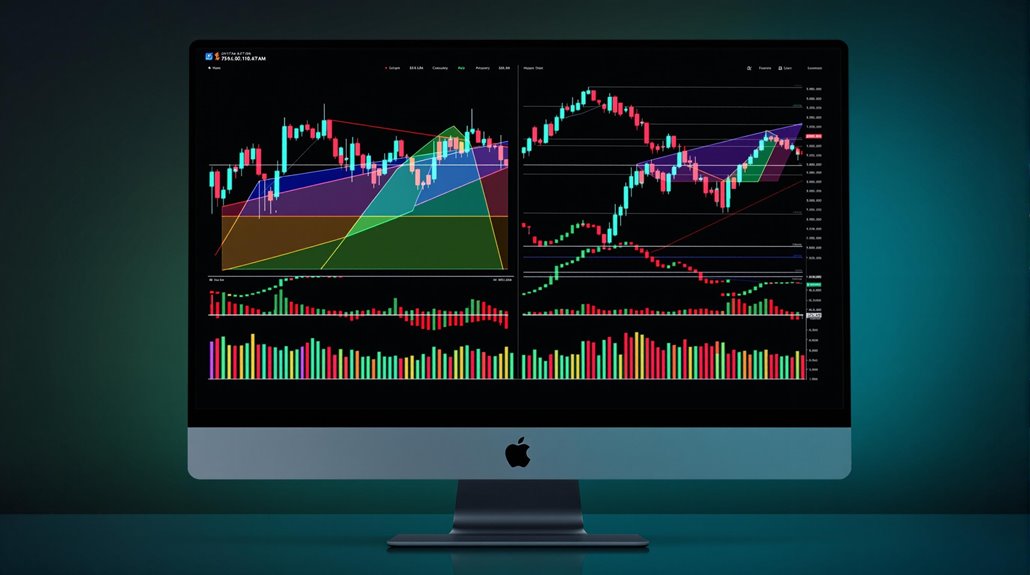Technical chart patterns provide statistically validated methods for market timing, with success rates reaching 75% when properly analyzed. Key formations include Head and Shoulders, Double Tops/Bottoms, Triangles, and Cup and Handle patterns, each offering distinct entry and exit signals when confirmed by volume characteristics. Professional traders enhance reliability by combining multiple pattern types with support/resistance levels and broader market conditions. Understanding these essential patterns reveals advanced trading opportunities across various market environments.
Key Takeaways
- Head and Shoulders patterns achieve high reliability when volume decreases during right shoulder formation and surges during neckline breakout.
- Triangle patterns offer 72% success rates when confirmed by volume expansion and multiple price closes beyond the trendline.
- Double bottoms show 68% success with significant gains, making them more reliable than double tops for market timing.
- Cup and Handle patterns signal strong bullish continuation when accompanied by high volume surge during the breakout phase.
- Multiple pattern confirmation strategy reduces false signals and increases trading success by requiring alignment of two or more formations.
Understanding the Power of Pattern Recognition in Trading

While chart patterns have long been a cornerstone of technical analysis, the systematic application of pattern recognition in trading has emerged as a powerful methodology for identifying repeatable price behaviors and potential market opportunities.
Research demonstrates that pattern recognition strategies, when properly implemented, can achieve success rates of up to 75% in forecasting price movements.
The statistical edge provided by pattern recognition becomes particularly evident when combined with thorough analytical frameworks that incorporate both technical and fundamental factors.
Studies validate that structured pattern-based approaches can effectively predict market direction across various indices and timeframes.
Traders who master double tops and bottoms often gain significant advantages in identifying potential market reversals at critical price levels.
Modern quantitative tools have enhanced the precision of pattern recognition, reducing subjective bias through algorithmic identification and measurement.
This technological advancement, coupled with rigorous backtesting and walk-forward analysis, enables traders to develop more reliable strategies that adapt to evolving market conditions while maintaining consistent performance metrics.
Market psychology plays a crucial role in price action analysis, allowing traders to interpret raw price movements without the lag of traditional indicators.
Mastering Head and Shoulders Pattern Analysis
Successful implementation of the Head and Shoulders pattern requires precise identification of strategic entry points, particularly at the neckline break where price action confirms the pattern’s completion.
Volume analysis serves as a critical confirmation tool, with increasing volume during the neckline breakdown indicating strong conviction in the reversal signal. A close examination of volume-price divergence can provide additional validation of the pattern’s reliability. Stop-loss orders should be placed at above the right shoulder to minimize risk exposure while maintaining position control.
Technical analysts typically monitor volume characteristics throughout pattern formation, noting specifically that diminishing volume during the right shoulder formation, followed by a surge during the breakout phase, provides the most reliable trading signals.
Identifying Pattern Entry Points
Mastering the art of identifying entry points in head and shoulders patterns requires a systematic approach built upon pattern recognition fundamentals and precise technical analysis.
Pattern psychology and entry strategies converge at the critical neckline breakout, where successful traders await decisive price action confirmation. The three distinct peaks formation serves as a reliable predictor of potential market reversals when properly identified. Similar to MACD crossovers, these reversals provide strong directional signals for traders.
Entry execution focuses on two primary approaches:
- Conservative entry after confirmed neckline breach with volume validation
- Aggressive entry before complete pattern formation, utilizing technical indicator confluence
Key confirmation signals include:
- Clear violation of neckline support/resistance
- Increased trading volume during breakout
- Retest of neckline providing secondary entry opportunity
- Alignment with broader market trends and timeframes
Risk management parameters must be established prior to entry, with stop-loss placement structured according to pattern dimensions and individual risk tolerance levels.
Volume Analysis for Breakouts
Volume analysis serves as a cornerstone of head and shoulders pattern validation, providing critical confirmation signals during both formation and breakout phases.
Volume trends during pattern development offer essential clues about the strength and reliability of potential reversals. Statistical evidence demonstrates that breakout strategies incorporating volume confirmation notably outperform those lacking such validation. Stop-loss orders can help protect against false breakouts when volume signals are mixed. Combining MACD oscillator readings with volume analysis provides an additional layer of trend confirmation.
Successful traders scrutinize declining volume during pattern formation, particularly noting decreased activity in the right shoulder compared to the head. When evaluating breakouts, practitioners seek substantial volume expansion at the neckline penetration point, as this surge typically correlates with more sustained price movements and higher probability measured move targets.
The absence of appropriate volume characteristics often precedes pattern failures, making volume analysis an indispensable component of technical pattern recognition methodology.
Trading Double Tops and Bottoms for Maximum Profit

Trading double tops and bottoms effectively requires an extensive understanding of their statistical reliability and precise execution parameters. Research indicates double bottom techniques demonstrate superior performance, with a 68% success rate and average gains of 40%, while double top strategies exhibit approximately half the target reach rate.
Statistical analysis from 1991-1996 across 500 stocks revealed compelling evidence for these formations’ reliability, particularly in double bottoms, which showed only 3% false signals. A trader’s success often depends on identifying the extremely bearish pattern that characterizes genuine double tops. These patterns become especially meaningful when they form at key support levels where historical buying interest tends to emerge.
- Entry points require confirmation through neckline breaks, with protective stops placed above peaks for double tops and below troughs for double bottoms.
- Pattern measurement projects price targets by calculating the vertical distance between extremes and necklines.
- Ideal execution occurs when patterns form at significant support/resistance zones following pronounced trends.
Volume analysis serves as a critical confirmation tool, typically showing declining activity during pattern formation and surging during breakouts, enhancing trading precision and profitability potential.
Triangle Patterns: Key Tools for Predicting Market Direction
Triangle patterns emerge as powerful technical indicators that offer traders systematic opportunities to capitalize on market breakouts.
Multiple timeframe analysis enhances the reliability of triangle pattern signals across different market conditions.
Successful trading of these formations requires careful attention to volume characteristics, with increasing volume during breakouts serving as a vital confirmation signal of pattern validity.
The strategic positioning of entry points, combined with proper volume analysis, enables traders to exploit high-probability setups while maintaining favorable risk-reward parameters through well-defined stop-loss levels. Three main variations of triangle patterns – ascending, descending, and symmetrical – provide distinct signals for different market conditions.
Trading Triangle Breakouts Successfully
Successful market technicians recognize triangle patterns as one of the most reliable technical formations for predicting potential breakout opportunities and future price movements.
These geometric configurations, characterized by converging trendlines, provide strategic entry and exit points when properly analyzed in conjunction with trading volume implications. With high probability setups, triangle patterns offer exceptional trading opportunities during periods of market consolidation. Similar to Bollinger Bands, these patterns excel at identifying periods of decreasing volatility before significant price moves.
- Triangle breakout strategies require confirmation through multiple price closes beyond the trendline, accompanied by significant volume expansion that validates the authenticity of the move.
- Ascending triangles typically presage bullish continuations, while descending formations often precede bearish movements, particularly when supported by corresponding volume patterns.
- Risk management protocols dictate positioning stop orders on the opposite side of breakout levels, with position sizing calibrated to account for potential false breakouts and market volatility.
Volume Confirms Pattern Strength
Astute market technicians recognize volume as the essential confirmatory element that validates triangle pattern strength and potential breakout direction. The analysis of volume behavior within these formations provides critical insight into the conviction behind price movements.
Volume divergence during triangle consolidation serves as an early warning system for potential pattern failures, while strong volume surges accompanying breakout validation greatly enhance trading confidence. Statistical research demonstrates that triangle patterns combined with volume confirmation achieve success rates over 72% in both ascending and descending formations.
Professional traders scrutinize declining volume during pattern formation, as this compression typically precedes decisive market moves. Traders often combine this analysis with RSI divergence patterns to identify potential trend reversals.
Successful triangle pattern trading requires systematic integration of volume analysis with technical indicators such as RSI and MACD for best results. When volume confirms price action through the pattern’s development and eventual breakout, traders gain a substantial edge in distinguishing genuine opportunities from false signals.
Flags and Pennants: Short-Term Trading Opportunities

Every experienced trader recognizes flags and pennants as powerful short-term continuation patterns that emerge during strong price trends, offering high-probability trading opportunities during brief consolidation periods.
Effective flag pattern analysis relies on identifying parallel trendlines forming a rectangle, while pennant trading strategies focus on converging lines creating a symmetrical triangle. Traders must exercise patience and avoid premature market entries during the consolidation phase.
These formations typically manifest over one to five weeks, presenting traders with structured entry and exit points:
- Entry positions are established just beyond the pattern’s breakout point, with stop-losses placed inside the opposite boundary.
- Volume confirmation serves as a critical component, as increased trading activity validates pattern completion.
- Price targets are calculated by projecting the flagpole length from the breakout point, providing measurable profit objectives.
The reliability of these patterns is enhanced when they form within established trends, particularly when accompanied by appropriate volume characteristics that validate the anticipated continuation. Success in trading these patterns requires implementing systematic trading approaches while maintaining strict emotional discipline.
Cup and Handle: The Classic Bullish Formation
Professional traders widely recognize the Cup and Handle as one of technical analysis’s most reliable bullish continuation patterns, characterized by its distinctive U-shaped consolidation followed by a shorter downward-drifting handle formation. The cup dynamics typically manifest over one to six months, with the handle significance emerging through a shorter one-to-four-week consolidation period. This pattern was first defined by O’Neil in his influential 1988 book on stock trading strategies. Many traders combine moving average crossovers with Cup and Handle patterns to confirm trend strength and potential entry points.
| Pattern Component | Duration | Key Characteristics |
|---|---|---|
| Cup Formation | 1-6 months | Rounded bottom, gradual price decline and recovery |
| Handle Formation | 1-4 weeks | 30-50% retracement of cup’s right side |
| Breakout Phase | Immediate | High volume surge, upward price movement |
The pattern’s reliability increases when specific criteria are met: the cup’s depth should not exceed 50% retracement from the peak, volume should decrease during formation but surge during breakout, and the handle should demonstrate lower volatility than the cup. Traders typically establish positions upon handle breakout, with profit targets calculated by projecting the cup’s depth above the resistance level.
Support and Resistance: Building Blocks of Technical Analysis
Technical analysts consider support and resistance levels the fundamental building blocks for understanding price action and market psychology in financial markets. These critical price points serve as psychological barriers where historical buying and selling pressures converge, creating observable patterns that traders can leverage for strategic decision-making.
Support dynamics and resistance strategies manifest through specific market behaviors that experienced traders monitor:
- Price levels that repeatedly halt downward movement become established support zones, while consistent upper barriers form resistance levels.
- Role reversal phenomena occur when broken support transforms into resistance, or breached resistance converts to support.
- Multiple tests of these levels without breakthrough typically strengthen their significance, though validation through volume analysis enhances reliability.
Understanding these concepts enables traders to identify potential entry and exit points while managing risk exposure through strategic position sizing and stop-loss placement. Moving averages can provide automatic support and resistance levels that traders use to simplify their analysis.
The effectiveness of these technical levels, however, requires confirmation through additional indicators and careful consideration of broader market conditions.
Combining Multiple Patterns for Enhanced Trading Results
While individual chart patterns provide valuable trading signals, combining multiple technical patterns across different timeframes and categories greatly enhances the reliability and robustness of market analysis.
Pattern synergy emerges when traders integrate reversal and continuation formations, creating multi pattern strategies that considerably reduce false signals.
The confluence benefits of timeframe alignment become evident when patterns appear simultaneously on daily, weekly, and monthly charts, offering superior signal robustness.
Professional traders leverage pattern diversity and algorithmic confirmation to enhance trading adaptability while implementing systematic risk mitigation protocols. Modern algorithmic trading platforms now enable automated pattern recognition across multiple timeframes simultaneously.
Research demonstrates that combining multiple pattern types across different timeframes yields superior results compared to single-pattern approaches.
By requiring two or more independent patterns to align before entry, traders achieve enhanced false signal reduction and improved win rates.
This disciplined approach to pattern analysis provides a framework for more consistent and profitable trading decisions.
Frequently Asked Questions
How Do Chart Patterns Perform Differently in Cryptocurrency Markets Versus Traditional Stocks?
Cryptocurrency markets demonstrate particularly different chart pattern behavior compared to traditional stocks, primarily due to heightened cryptocurrency volatility and unique trading psychology factors.
The 24/7 trading environment and lower liquidity in crypto markets lead to faster pattern formations and more frequent breakouts, though with potentially lower reliability.
While stock patterns typically develop over days or weeks with institutional participation providing stability, crypto patterns often manifest and complete within hours, requiring more aggressive risk management strategies.
What Percentage of Chart Patterns Fail During High-Volatility Market Conditions?
During periods of heightened market turbulence, chart pattern failures demonstrate a notable uptick from their baseline performance metrics.
Research indicates that failure rates typically increase by 10-20% above normal levels, with overall pattern effectiveness potentially declining to 40-60% during volatile conditions.
Traditional success rates of well-established patterns, such as double tops (73%) and V reversals (63%), experience significant deterioration when market volatility disrupts their structural integrity and generates increased false breakouts.
Can Chart Patterns Be Effectively Combined With Elliott Wave Theory?
Elliott Wave Integration and Chart Pattern Synergy can be effectively combined to enhance market analysis precision.
The synthesis of these methodologies provides traders with a thorough framework for:
- Identifying high-probability trade setups through pattern confirmation
- Validating wave counts using traditional chart formations
- Strengthening entry/exit timing through overlapping signals
- Leveraging Fibonacci relationships common to both approaches
This integrated approach considerably improves forecasting accuracy when compared to using either methodology in isolation.
Do Chart Patterns Work Equally Well Across Different Trading Timeframes?
Chart patterns demonstrate varying levels of reliability across different timeframes, with distinct characteristics impacting their effectiveness.
Short-term patterns on lower timeframes (1-15 minutes) frequently generate false signals due to market noise and volatility.
Conversely, long-term patterns on higher timeframes (daily, weekly) exhibit enhanced reliability due to reduced noise and stronger trend confirmation.
Multi-timeframe analysis, combining pattern recognition across different time horizons, typically yields the most robust trading results.
How Do Seasonal Factors Affect the Reliability of Technical Chart Patterns?
Like a garden blooming in spring, technical chart patterns demonstrate varying levels of effectiveness across different seasonal market conditions.
Research shows pattern reliability increases markedly when aligned with established seasonal trends, particularly during high-volume periods like November-April. The S&P 500’s historical 7.5% returns during these months validate stronger pattern signals.
However, summer doldrums and low-liquidity periods can diminish pattern effectiveness, requiring traders to adjust their strategies according to seasonal market dynamics.
Conclusion
While skeptics argue that technical analysis relies too heavily on historical data to predict future movements, the systematic application of proven chart patterns remains an indispensable component of successful market timing. When traders combine multiple pattern recognition techniques with robust risk management protocols, they can identify high-probability trading opportunities across various market conditions. This structured approach to technical analysis provides a repeatable methodology for achieving consistent trading results.
References
- https://www.fidelity.com/bin-public/060_www_fidelity_com/documents/learning-center/Idenitfying-Chart-Patterns.pdf
- https://www.ig.com/en/trading-strategies/10-chart-patterns-every-trader-needs-to-know-190514
- https://www.investopedia.com/articles/technical/112601.asp
- https://www.forex.com/en-us/learn-forex-trading/11-chart-patterns-you-should-know/
- https://www.oanda.com/us-en/trade-tap-blog/trading-knowledge/chart-patterns-in-technical-analysis-a-comprehensive-guide/
- https://site.financialmodelingprep.com/education/unveiling-the-power-of-pattern-recognition-in-stock-trading
- https://ninjatrader.com/futures/blogs/the-statistical-analysis-of-trading-patterns/
- https://www.jpmorgan.com/technology/technology-blog/searching-for-patterns
- https://www.strike.money/technical-analysis/chart-patterns
- https://chartswatcher.com/pages/blog/effective-stock-market-pattern-recognition-for-traders

